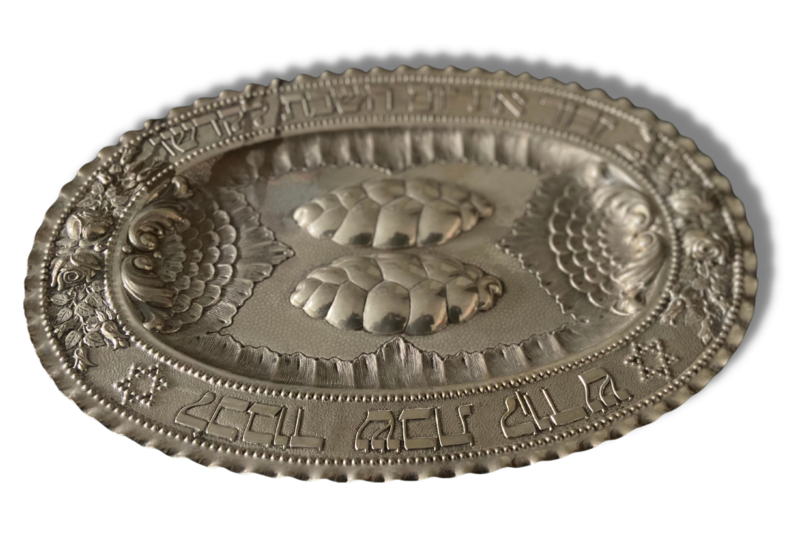
Museum Musings
January & February 2023

A Taste of Tradition
In perusing many synagogue calendars for the months of January and February, and part of March, 2023 (parts of Tevet, Shevat and Adar, 5783 in the Jewish calendar) I noted that there was only one Jewish holiday listed: Tu B’shvat. Martin Luther King Day, and Lincoln’s and Washington’s birthdays, graced the secular calendar. No yontiff. No hagim in the Jewish calendar from Hanukkah in December until Tu B’shvat on February 6. However, one significant Jewish event does appear: Shabbat, a block of time that recurs weekly, and with its presence recalls past generations as we live out our contemporary lives. Our synagogue cookbook, A Taste of Tradition, describes it in this way: Shabbat, rolling in each week, is regarded by the rabbis as the pre-eminent festival; it overrides blowing the shofar on Rosh Hashanah and carrying the lulav on Sukkot. In the Shabbat Kiddush, we remember God’s creation of the world, from which he rested on the seventh day, and we recall the exodus from Egypt, from when we moved from slavery to nationhood. The Shabbat candles renew spiritual connections; the carefully set table and the festive foods repair frayed spirits.
I asked several people to free-associate the word Shabbat. Phrases like synagogue prayer, renewal, family, Kiddush, candles, cholent, gefilte fish, and Shabbat dinner were always mentioned. And not surprisingly challah was at the top of the list. Food has always been an integral part of the Shabbat ritual, as it is indeed with most Jewish holidays. The old saw rings true as some recount Jewish History thusly: “They tried to kill us. We won. Let’s eat.”
Everyone is aware that Challah is THE bread for Shabbat, particularly in Ashkenazi homes. Other communities have their own recipes for Shabbat loaves. The origin of this tradition of Challah is traced to the shewbread that God commanded the priests to place on the shewbread table in the Temple (Numbers 15:19-20 and Exodus 25:30 ) To commemorate the double portion of manna that God sent to the Israelites wandering in the desert, each Shabbat, we place two loaves of Challah on our Shabbat tables. The term Challah חלה is derived from the Hebrew word, used for “portion” in the Biblical commandment: “of the first of your dough shall you give unto the Lord a portion for a gift throughout your generations.”
The name Challah was given to bread in South Germany in the Middle Ages, when it was adopted by Jews for Shabbat. It was the traditional Sunday loaf, and various shapes and sizes, were in the local tradition of decorative breads. Today, many people bake their own Shabbat and Yom Tov challot. My family is the fortunate recipient of home-made challot. Over the years, my lovely daughter-in-law, Deb, often with her children and/or young nieces/nephews helping, creates two sumptuous braided loaves for Shabbat meals and round ones for Yom Tov dinners.
Our Temple Emanu-El cookbook, A Taste of Tradition, includes Wileen Rosner Snow’s delicious recipe for challah. She reflected: “For many years, my grandfather, and then my mother made this challah recipe. The aroma is divine and helps to welcome Shabbat.”
When making the challah, it is required to take a small piece of dough, usually the size of an olive, before shaping the loaves. Before baking, that small piece is tossed into a hot oven and the baker says the following prayer in memory of the offering in Temple days: Blessed are you, Lord our God, Ruler of the universe, who has sanctified us with Your commandments and has commanded us to separate the challah. This ritual is called, “taking challah.” Both men and women perform it, but it is one of three mitzvot along with lighting the Shabbat candles and ritual immersion in the mikvah that are especially for women.
There is a tradition in folklore surrounding the making and serving of challah. A simple white napkin or beautifully decorated cloth, representing the dew that collected on the manna in the morning, covers the breads. Poppy or sesame seeds sprinkled on the bread symbolize the manna that fell from heaven. Various sizes and shapes from braided in three, four or six strands looking like intertwined arms symbolize love three braids symbolize truth, peace and justice; round loaves, where there is no beginning and no end are baked for Rosh Hashanah to symbolize continuity, with raisins to add sweetness to the year-- and the list goes on with different representative shapes for various holidays.
Whether making or kneading a traditional challah by hand as in days of old, or are using the modern convenience of a bread machine, to create a whole wheat or vegan challah the result is the same. The distinctive aroma that permeates the home in which a challah is baked recalls the generations of Jews throughout the ages for whom challah has played an integral role. As Ahad Ha-am, one of the most important early Jewish writers of the last century wrote: “More than the Jewish people has preserved the Shabbat, Shabbat has preserved the Jewish people.” And challah, an icon of Shabbat, has played a singular role (no pun intended) in that process.
This exquisite silver repousse challah plate, pictured above, is from the collection of the Abraham and Natalie Percelay Museum of Temple Emanu-El. Around the perimeter in Hebrew are the blessings over the challah and in the center are two braided loaves of color this magnificent and highly ornamental platter created in 20th century Hungary, was a gift to the museum in memory of Jack Mellion by his friends.
-Ruth Page
Museum Director
With thanks to Claudia Roden’s The Book of Jewish Food, and our own Temple Emanuel’s A Taste of Tradition for some information used in this article
Contributions to the museum are a special way to remember those you wish to honor on memorialize send your donations to the synagogue. Attention: Museum
